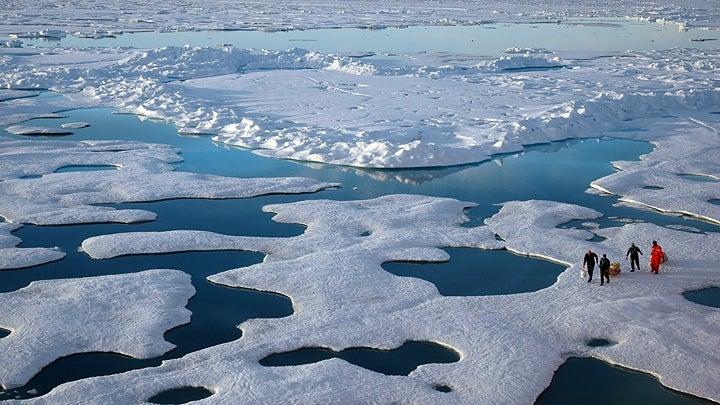How the hottest summer ever affected the Arctic: 5 things you need to know (Indian Express)

- 16 Dec 2023
Why is it in the News?
Rising temperatures in the Arctic have led to unprecedented wildfires that forced communities to evacuate, a decline in sea ice extent, devastating floods, food insecurity, and a rise in sea level.
Highlights from the Arctic Report Card 2023:
- The period from October 2022 to September 2023 ranked as the sixth-warmest year in the Arctic since the initiation of record-keeping in 1900.
- Notably, this timeframe aligns with the Arctic monitoring year, spanning from October to September to cover the region's cold season.
- This marks the 14th consecutive year wherein Arctic temperatures surpassed the average recorded between 1991 and 2020.
- The elevated temperatures observed in the northern polar region had significant consequences, including unprecedented wildfires necessitating community evacuations, a reduction in sea ice coverage, severe floods, concerns about food security, and an elevation in sea levels.
The most severe consequences of the soaring temperatures in the Arctic:
- Thawing of Subsea permafrost: Subsea permafrost is essentially frozen soil beneath the seabed that contains organic matter.
- While it has been gradually thawing for thousands of years, warmer ocean temperatures are accelerating this process.
- When subsea permafrost thaws, the organic matter it contains decays and releases methane and carbon dioxide – greenhouse gases that contribute to global warming and worsen ocean acidification.
- Food insecurity: Due to the impact of climate change on freshwater bodies and marine ecosystems, Western Alaska recorded another year of extremely low numbers of Chinook and chum salmon. The size of adult salmon has also decreased.
- It led to fishery closures, worsened user conflicts, and had profound cultural and food security impacts in Indigenous communities that have been tied to salmon for millennia.
- Interestingly, while the population of Chinook and chum salmon declined, sockeye salmon increased in Western Alaska.
- According to scientists, the diverging impacts are affecting Indigenous communities that depend on the salmon for food, and challenging fishery managers as the different species respond in unique ways to the warming climate.
- Raging wildfires: Canada with 40% of its land mass is considered Arctic and Northern was among the worst affected regions when it comes to wildfires.
- Canada witnessed its worst wildfire season on record with fires burning more than 10 million acres in the Northwest Territories.
- This happened as high temperatures dried up vegetation and soil, coupled with below-average rainfall, creating perfect conditions for wildfires.
- Canada witnessed its worst wildfire season on record with fires burning more than 10 million acres in the Northwest Territories.
- Severe flooding: Rising temperatures have led to dramatic thinning of the Mendenhall Glacier, located in Alaska, over the past 20 years.
- As a result, over the years, the meltaway water has annually caused floods in the region.
- One such disaster took place in August 2023, when a glacial lake on a tributary of the Mendenhall Glacier burst through its ice dam.
- It caused unprecedented flooding and severe property damage” in Alaska’s Juneau.
- Greenland ice sheet melting: The highest point on Greenland’s ice sheet experienced melting for only the fifth time in the 34-year record.
- Not only this, the ice sheet continued to lose mass despite above-average winter snow accumulation.
- Between August 2022 and September 2023, it lost roughly 350 trillion pounds of mass.
- Notably, Greenland’s ice sheet melting is the second-largest contributor to sea-level rise.
